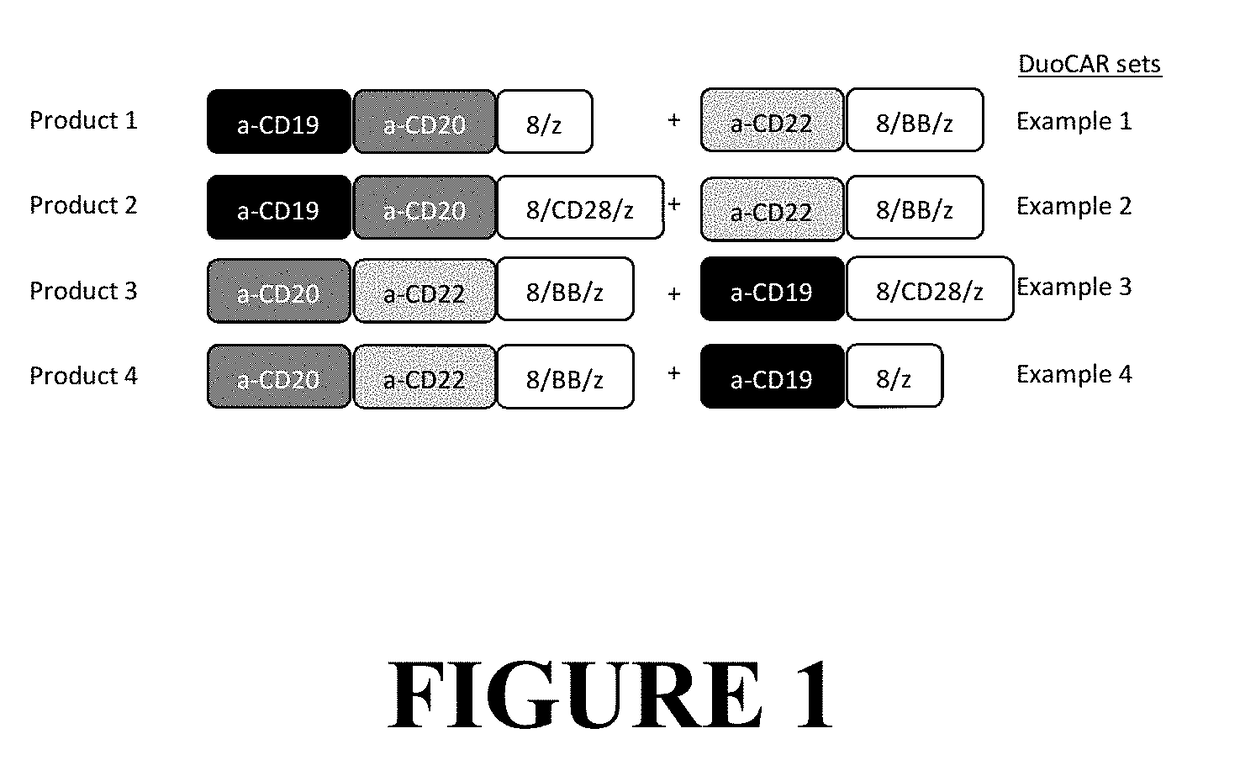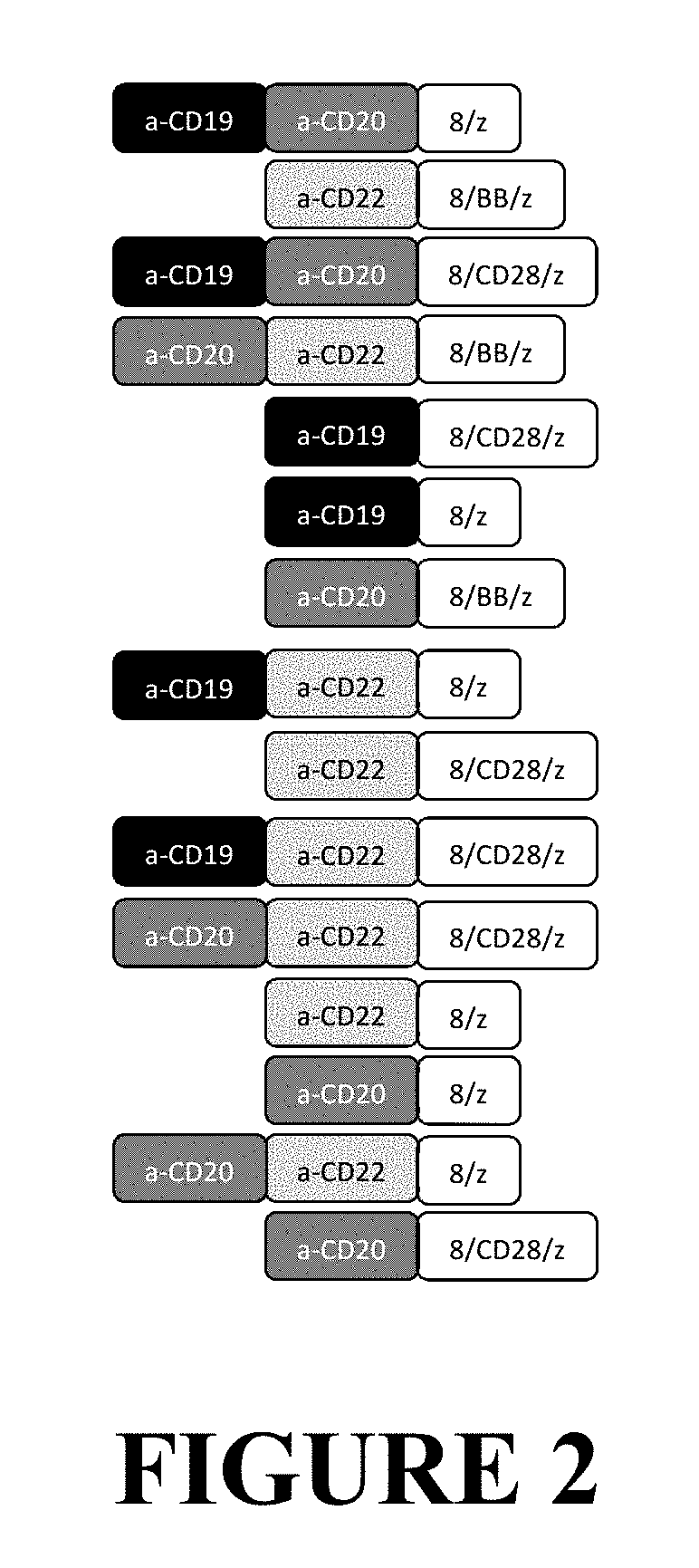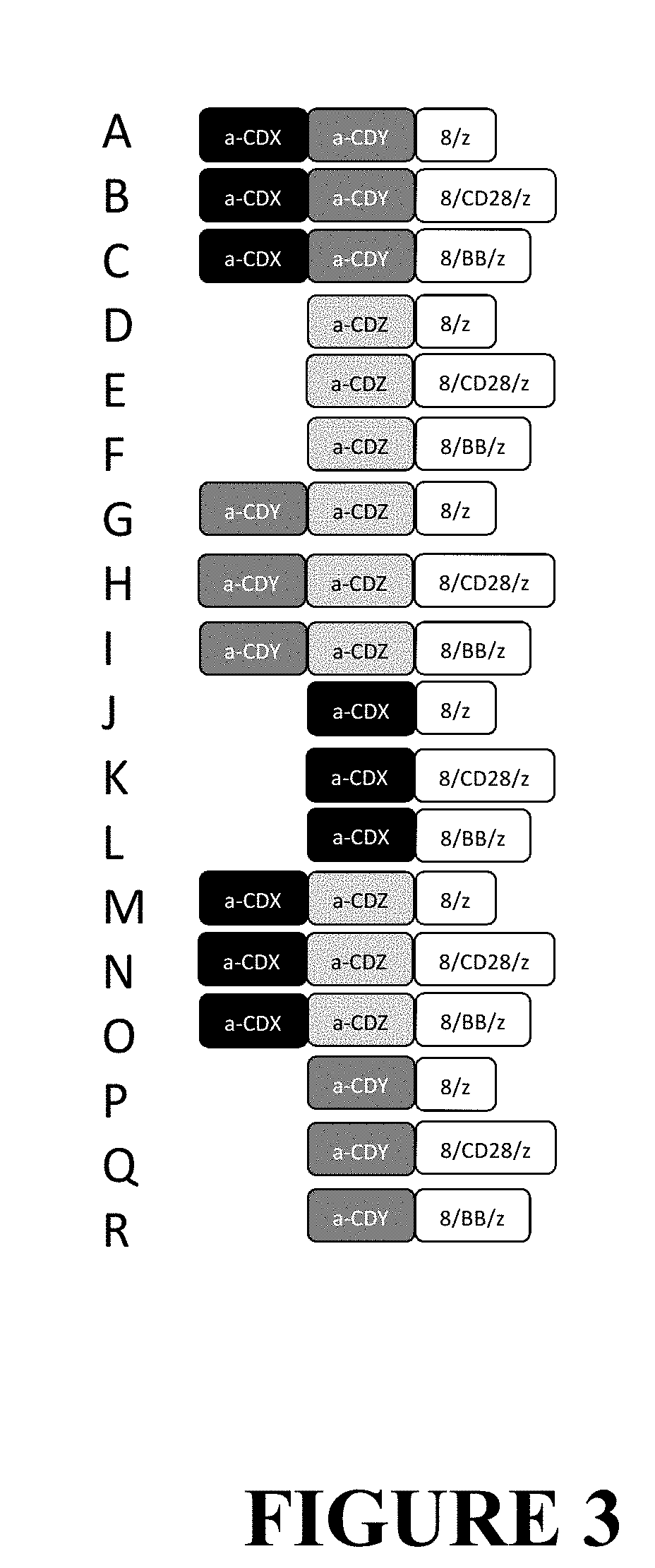Compositions and Methods for Treating Cancer with DuoCARs
a cancer and duocar technology, applied in the field of cancer, can solve the problems of patient's tumor growth unimpeded, affecting the treatment effect, and the amount of time that elapses between, so as to prevent or ameliorate the recurrence of malignant diseas
- Summary
- Abstract
- Description
- Claims
- Application Information
AI Technical Summary
Benefits of technology
Problems solved by technology
Method used
Image
Examples
example 1
Expression of a DuoCAR (2+1 DuoSet) on Primary Human T Cells
[0324]As a proof of principle, a DuoSet comprised of two CAR-T vectors was created. One member of the set expressed a tandem CD20_CD19 binding domain linked to CD8 transmembrane and CD28 and CD3-zeta signaling domains (LTG2228), SEQ ID NO: 51 and SEQ ID NO: 52. The second member of the DuoSet was a CAR construct with a single CD22 binder linked to CD8 transmembrane and 4-1BB and CD3-zeta signaling domains (LTG2200), SEQ ID NO: 9 and SEQ ID NO: 10. In FIG. 7, the paired columns show dual staining for CD20 and CD19 scFvs, left column, and CD22 and CD19 scFvs, right column. Row 1 shows T cells that were not transduced (UTD) and thus show no binding. Row 2 shows T cells transduced with LV encoding a CD20_CD19 CAR vector with a CD8 transmembrane and intracellular CD28 and CD3-zeta signaling domains (20-19-28z). While dual staining is seen for CD20 and CD19 binding (left panel), only CD19 binding is seen in the right panel. Row 3...
example 2
Anti-Leukemia Activity of a Human T Cell Preparation Expressing DuoCARs Generated by Co-Transduction Method
[0325]Anti-leukemia activity of a human T cell preparation expressing a DuoCAR that targets three leukemia antigens simultaneously (c.f., see FIG. 7 for DuoCAR expression characteristics). A DuoSet comprised of a CD20_19 tandem CAR and a CD22-specific single CAR (prepared as in Example 1) was used an effector T cell population in a cytotoxic T cell assay using leukemia cell line and model cell lines as targets. Human T cells transduced with single CAR components (20_19-28z or 22-BBz) or DuoCARs (20_19-28z+22-BBz), were used in cytotoxic T cells assay at four different effector to target ratios (20:1, 10:1, 5:1, 2.5:1, as indicated) (cf, see FIG. 8). The leukemia cell lines used as CAR-T targets were: Raji (expresses all three target antigens), REH (expresses all three target antigens), K562 (control, no targets expressed), K562-CD19 (expresses CD19), K562-CD20 (expresses CD20),...
example 3
Anti-Leukemia Activity of a Human T Cell Preparation Expressing DuoCARs Generated by Co-Transfection Methods
[0326]The DuoCAR technology described in this application generates a population of therapeutic lymphocytes, in this example human T cells, that express more than two antigen specificities from more than one transmembrane protein encoded by a gene vector. In this example, this is achieved by two different means. FIG. 9 contains three rows of data, labeled “un-transduced,”“co-transduction,” and “co-transfection”. FIG. 9 contains two columns of data, generated as in FIG. 7, wherein the first column is analyzed by flow cytometry for the expression of CD20- and CD19-specific specific binding, and the second column is analyzed by flow cytometry for the expression of CD22- and CD19-binding activity. In the first row of data, un-transduced human T cells are shown. No binding activity is seen for the CD19, CD20, or CD22 recombinant protein indicators of CAR-derived binding activity, d...
PUM
 Login to View More
Login to View More Abstract
Description
Claims
Application Information
 Login to View More
Login to View More - R&D
- Intellectual Property
- Life Sciences
- Materials
- Tech Scout
- Unparalleled Data Quality
- Higher Quality Content
- 60% Fewer Hallucinations
Browse by: Latest US Patents, China's latest patents, Technical Efficacy Thesaurus, Application Domain, Technology Topic, Popular Technical Reports.
© 2025 PatSnap. All rights reserved.Legal|Privacy policy|Modern Slavery Act Transparency Statement|Sitemap|About US| Contact US: help@patsnap.com



